Giving Instructions in the Second-Language Classroom
VerifiedAdded on 2023/01/31
|14
|3371
|49
AI Summary
This article discusses the importance of giving clear instructions in the second-language classroom and provides techniques for effective instruction-giving. It emphasizes the impact of instruction-giving on learning and highlights the role of classroom management in the teaching process. The article also offers tips on preparation and delivery stages of instruction-giving, including the use of support mechanisms, getting students' attention, speaking clearly, and using short, simple, and clear instructions. It emphasizes the need for modeling, breaking down instructions, giving time limits, and checking for understanding. Overall, it provides valuable insights for teachers to enhance their instruction-giving skills.
Contribute Materials
Your contribution can guide someone’s learning journey. Share your
documents today.

GIVING
INSTRUCTIONS
TEACHER: Caceres Veronica
STUDENT: Navarro Jemina Esther
SUBJECT: Teaching Practice III
COURSE: 3B
YEAR: 2020/2021
COLLOQUIUM: “Giving Instructions”
INSTRUCTIONS
TEACHER: Caceres Veronica
STUDENT: Navarro Jemina Esther
SUBJECT: Teaching Practice III
COURSE: 3B
YEAR: 2020/2021
COLLOQUIUM: “Giving Instructions”
Secure Best Marks with AI Grader
Need help grading? Try our AI Grader for instant feedback on your assignments.
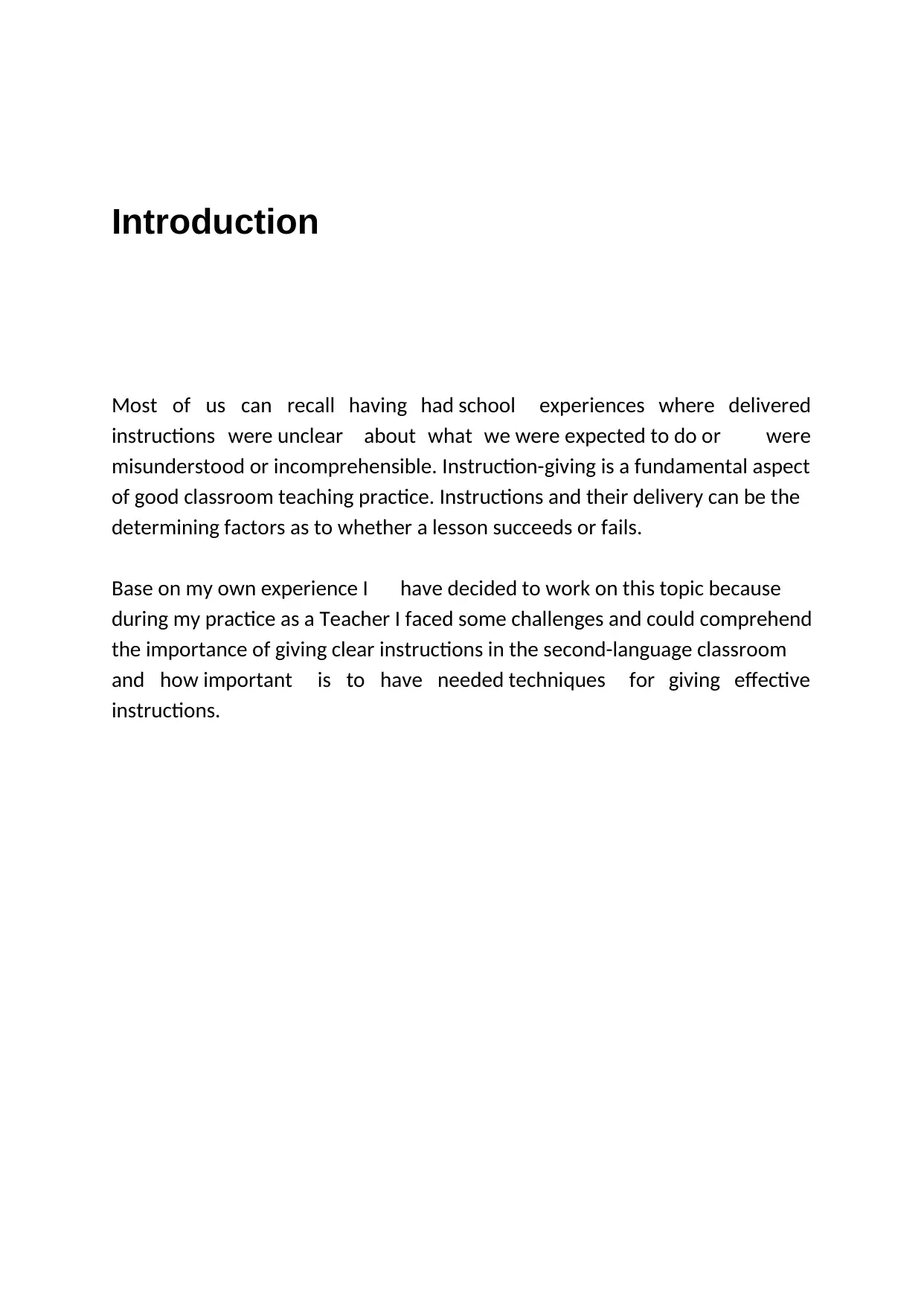
Introduction
Most of us can recall having had school experiences where delivered
instructions were unclear about what we were expected to do or were
misunderstood or incomprehensible. Instruction-giving is a fundamental aspect
of good classroom teaching practice. Instructions and their delivery can be the
determining factors as to whether a lesson succeeds or fails.
Base on my own experience I have decided to work on this topic because
during my practice as a Teacher I faced some challenges and could comprehend
the importance of giving clear instructions in the second-language classroom
and how important is to have needed techniques for giving effective
instructions.
Most of us can recall having had school experiences where delivered
instructions were unclear about what we were expected to do or were
misunderstood or incomprehensible. Instruction-giving is a fundamental aspect
of good classroom teaching practice. Instructions and their delivery can be the
determining factors as to whether a lesson succeeds or fails.
Base on my own experience I have decided to work on this topic because
during my practice as a Teacher I faced some challenges and could comprehend
the importance of giving clear instructions in the second-language classroom
and how important is to have needed techniques for giving effective
instructions.
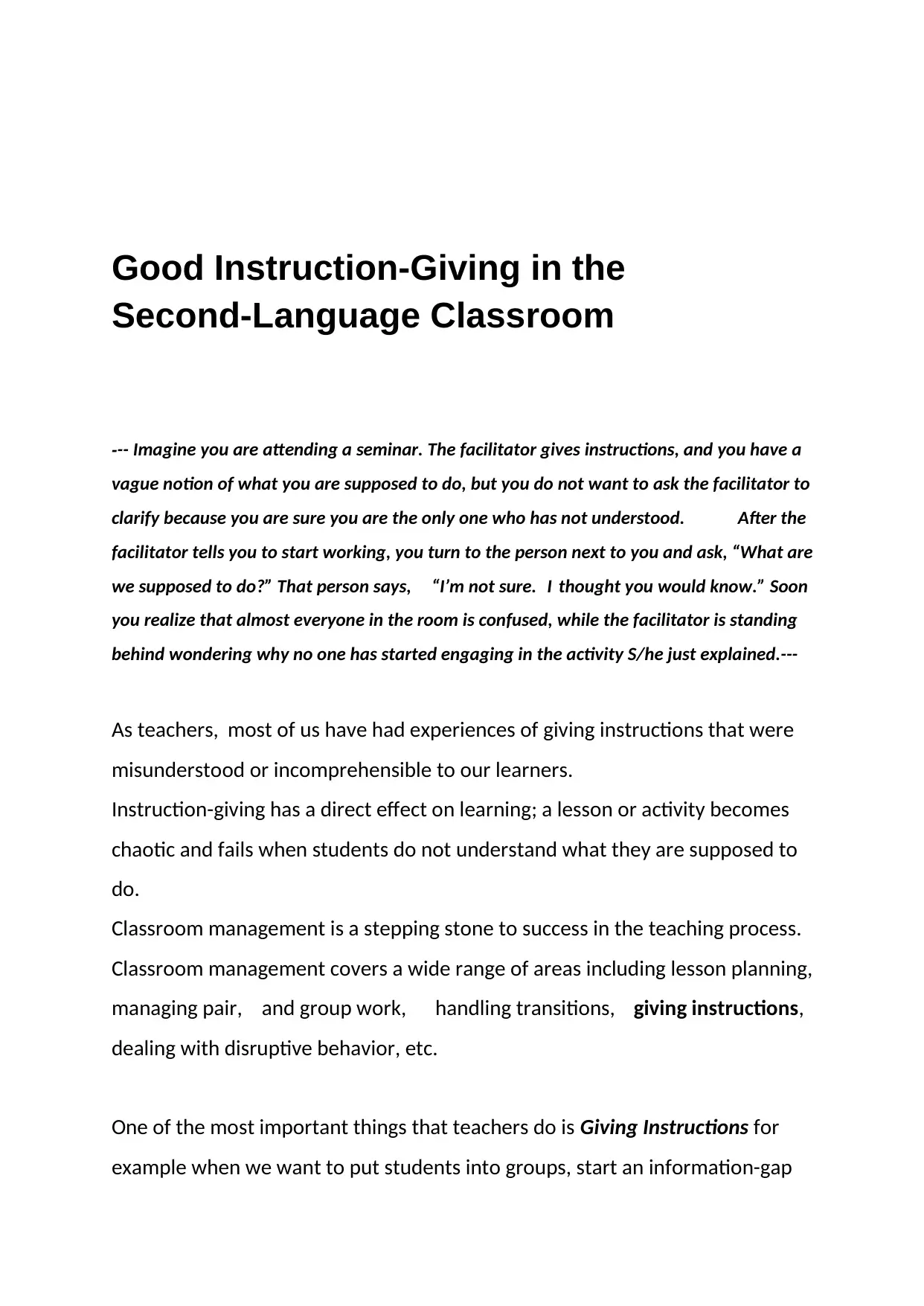
Good Instruction-Giving in the
Second-Language Classroom
--- Imagine you are attending a seminar. The facilitator gives instructions, and you have a
vague notion of what you are supposed to do, but you do not want to ask the facilitator to
clarify because you are sure you are the only one who has not understood. After the
facilitator tells you to start working, you turn to the person next to you and ask, “What are
we supposed to do?” That person says, “I’m not sure. I thought you would know.” Soon
you realize that almost everyone in the room is confused, while the facilitator is standing
behind wondering why no one has started engaging in the activity S/he just explained.---
As teachers, most of us have had experiences of giving instructions that were
misunderstood or incomprehensible to our learners.
Instruction-giving has a direct effect on learning; a lesson or activity becomes
chaotic and fails when students do not understand what they are supposed to
do.
Classroom management is a stepping stone to success in the teaching process.
Classroom management covers a wide range of areas including lesson planning,
managing pair, and group work, handling transitions, giving instructions,
dealing with disruptive behavior, etc.
One of the most important things that teachers do is Giving Instructions for
example when we want to put students into groups, start an information-gap
Second-Language Classroom
--- Imagine you are attending a seminar. The facilitator gives instructions, and you have a
vague notion of what you are supposed to do, but you do not want to ask the facilitator to
clarify because you are sure you are the only one who has not understood. After the
facilitator tells you to start working, you turn to the person next to you and ask, “What are
we supposed to do?” That person says, “I’m not sure. I thought you would know.” Soon
you realize that almost everyone in the room is confused, while the facilitator is standing
behind wondering why no one has started engaging in the activity S/he just explained.---
As teachers, most of us have had experiences of giving instructions that were
misunderstood or incomprehensible to our learners.
Instruction-giving has a direct effect on learning; a lesson or activity becomes
chaotic and fails when students do not understand what they are supposed to
do.
Classroom management is a stepping stone to success in the teaching process.
Classroom management covers a wide range of areas including lesson planning,
managing pair, and group work, handling transitions, giving instructions,
dealing with disruptive behavior, etc.
One of the most important things that teachers do is Giving Instructions for
example when we want to put students into groups, start an information-gap
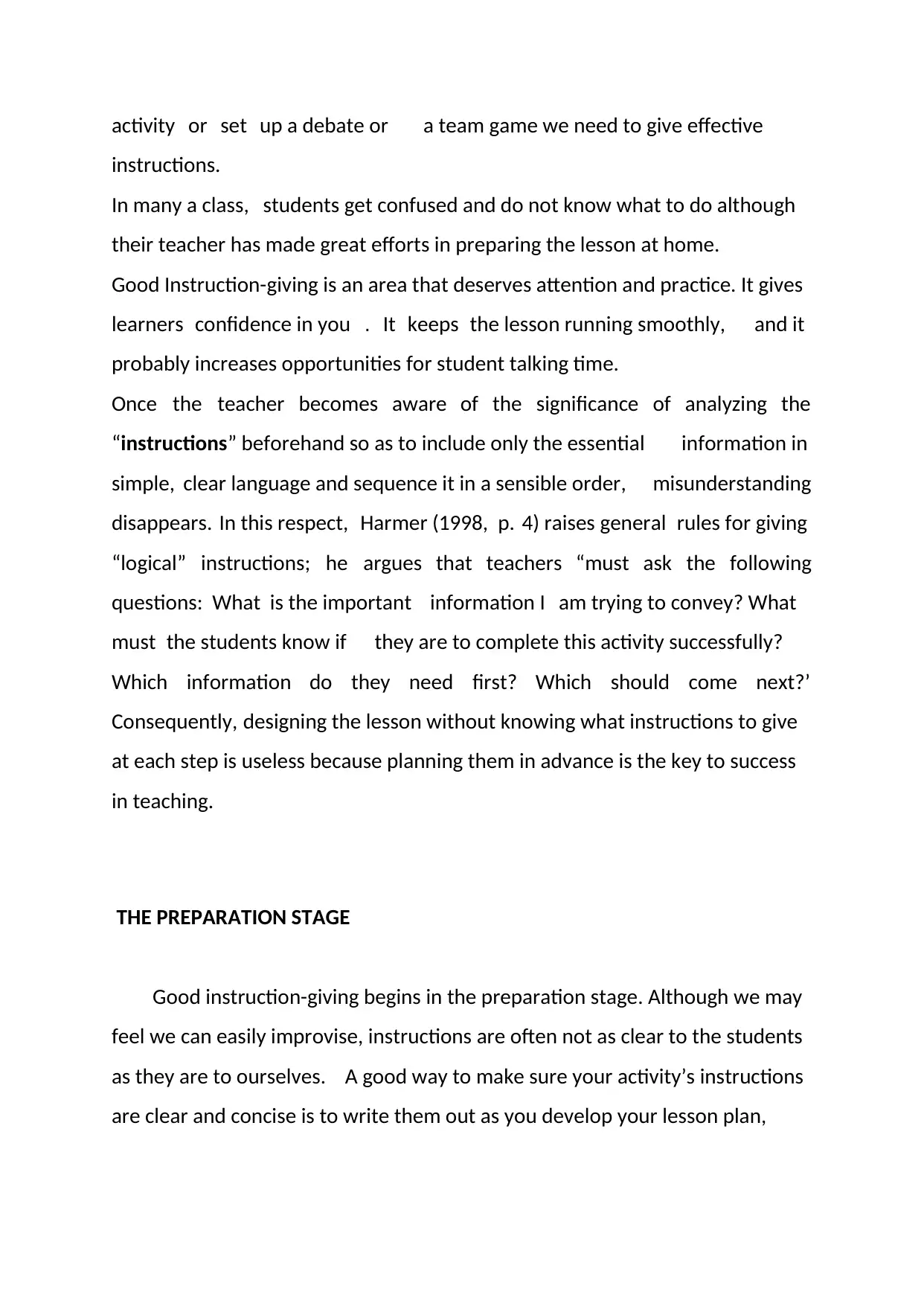
activity or set up a debate or a team game we need to give effective
instructions.
In many a class, students get confused and do not know what to do although
their teacher has made great efforts in preparing the lesson at home.
Good Instruction-giving is an area that deserves attention and practice. It gives
learners confidence in you . It keeps the lesson running smoothly, and it
probably increases opportunities for student talking time.
Once the teacher becomes aware of the significance of analyzing the
“instructions” beforehand so as to include only the essential information in
simple, clear language and sequence it in a sensible order, misunderstanding
disappears. In this respect, Harmer (1998, p. 4) raises general rules for giving
“logical” instructions; he argues that teachers “must ask the following
questions: What is the important information I am trying to convey? What
must the students know if they are to complete this activity successfully?
Which information do they need first? Which should come next?’
Consequently, designing the lesson without knowing what instructions to give
at each step is useless because planning them in advance is the key to success
in teaching.
THE PREPARATION STAGE
Good instruction-giving begins in the preparation stage. Although we may
feel we can easily improvise, instructions are often not as clear to the students
as they are to ourselves. A good way to make sure your activity’s instructions
are clear and concise is to write them out as you develop your lesson plan,
instructions.
In many a class, students get confused and do not know what to do although
their teacher has made great efforts in preparing the lesson at home.
Good Instruction-giving is an area that deserves attention and practice. It gives
learners confidence in you . It keeps the lesson running smoothly, and it
probably increases opportunities for student talking time.
Once the teacher becomes aware of the significance of analyzing the
“instructions” beforehand so as to include only the essential information in
simple, clear language and sequence it in a sensible order, misunderstanding
disappears. In this respect, Harmer (1998, p. 4) raises general rules for giving
“logical” instructions; he argues that teachers “must ask the following
questions: What is the important information I am trying to convey? What
must the students know if they are to complete this activity successfully?
Which information do they need first? Which should come next?’
Consequently, designing the lesson without knowing what instructions to give
at each step is useless because planning them in advance is the key to success
in teaching.
THE PREPARATION STAGE
Good instruction-giving begins in the preparation stage. Although we may
feel we can easily improvise, instructions are often not as clear to the students
as they are to ourselves. A good way to make sure your activity’s instructions
are clear and concise is to write them out as you develop your lesson plan,
Secure Best Marks with AI Grader
Need help grading? Try our AI Grader for instant feedback on your assignments.
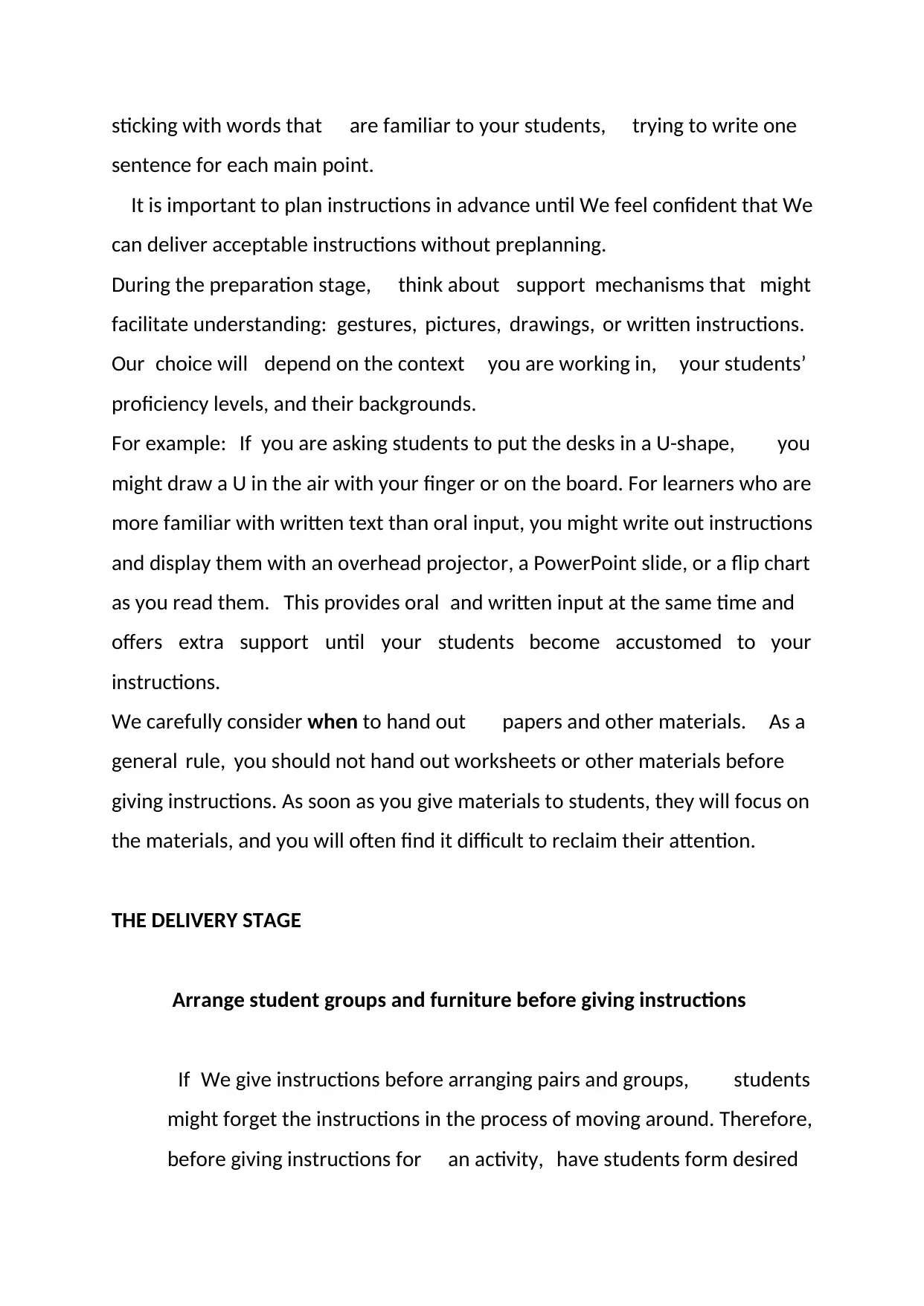
sticking with words that are familiar to your students, trying to write one
sentence for each main point.
It is important to plan instructions in advance until We feel confident that We
can deliver acceptable instructions without preplanning.
During the preparation stage, think about support mechanisms that might
facilitate understanding: gestures, pictures, drawings, or written instructions.
Our choice will depend on the context you are working in, your students’
proficiency levels, and their backgrounds.
For example: If you are asking students to put the desks in a U-shape, you
might draw a U in the air with your finger or on the board. For learners who are
more familiar with written text than oral input, you might write out instructions
and display them with an overhead projector, a PowerPoint slide, or a flip chart
as you read them. This provides oral and written input at the same time and
offers extra support until your students become accustomed to your
instructions.
We carefully consider when to hand out papers and other materials. As a
general rule, you should not hand out worksheets or other materials before
giving instructions. As soon as you give materials to students, they will focus on
the materials, and you will often find it difficult to reclaim their attention.
THE DELIVERY STAGE
Arrange student groups and furniture before giving instructions
If We give instructions before arranging pairs and groups, students
might forget the instructions in the process of moving around. Therefore,
before giving instructions for an activity, have students form desired
sentence for each main point.
It is important to plan instructions in advance until We feel confident that We
can deliver acceptable instructions without preplanning.
During the preparation stage, think about support mechanisms that might
facilitate understanding: gestures, pictures, drawings, or written instructions.
Our choice will depend on the context you are working in, your students’
proficiency levels, and their backgrounds.
For example: If you are asking students to put the desks in a U-shape, you
might draw a U in the air with your finger or on the board. For learners who are
more familiar with written text than oral input, you might write out instructions
and display them with an overhead projector, a PowerPoint slide, or a flip chart
as you read them. This provides oral and written input at the same time and
offers extra support until your students become accustomed to your
instructions.
We carefully consider when to hand out papers and other materials. As a
general rule, you should not hand out worksheets or other materials before
giving instructions. As soon as you give materials to students, they will focus on
the materials, and you will often find it difficult to reclaim their attention.
THE DELIVERY STAGE
Arrange student groups and furniture before giving instructions
If We give instructions before arranging pairs and groups, students
might forget the instructions in the process of moving around. Therefore,
before giving instructions for an activity, have students form desired
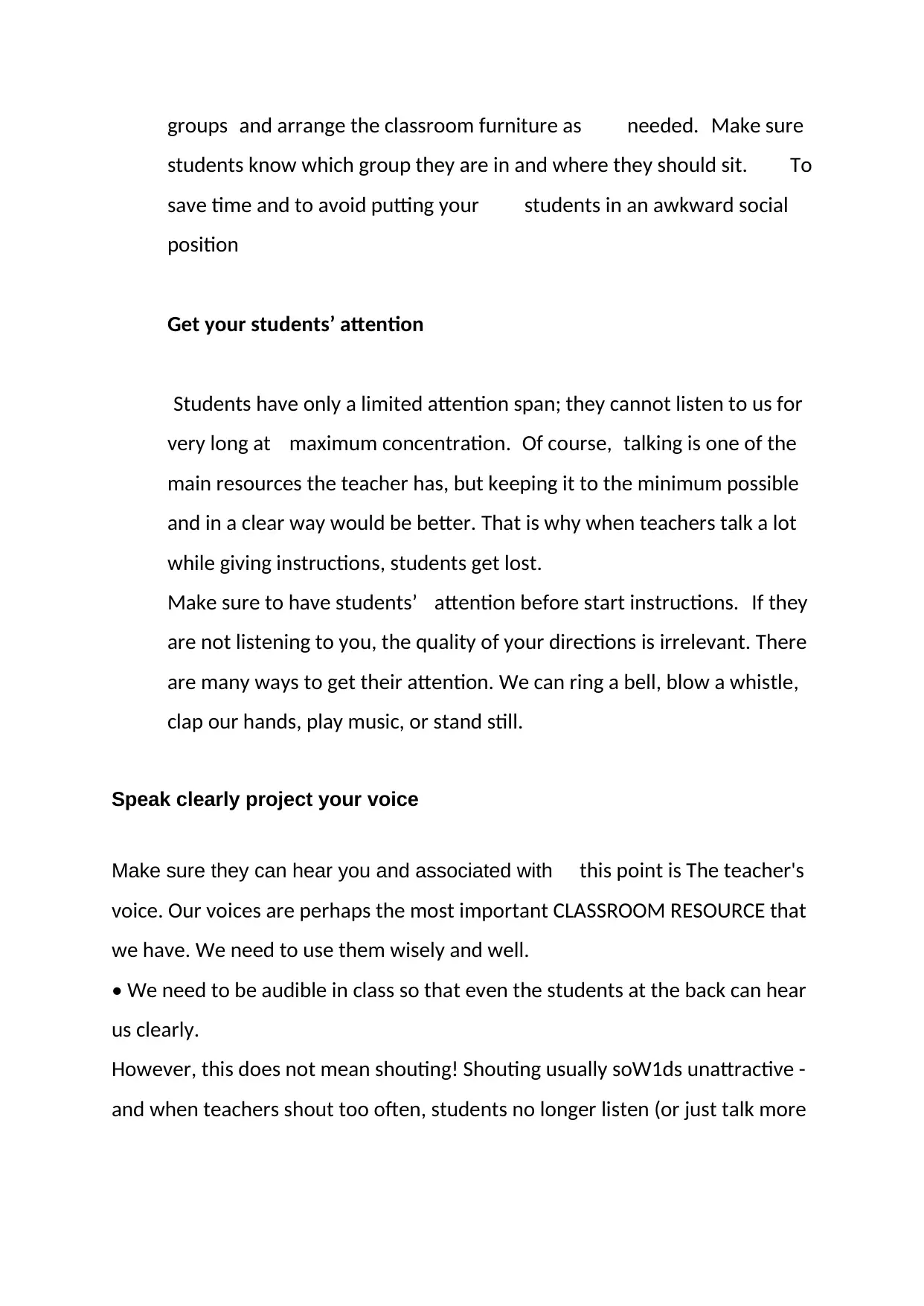
groups and arrange the classroom furniture as needed. Make sure
students know which group they are in and where they should sit. To
save time and to avoid putting your students in an awkward social
position
Get your students’ attention
Students have only a limited attention span; they cannot listen to us for
very long at maximum concentration. Of course, talking is one of the
main resources the teacher has, but keeping it to the minimum possible
and in a clear way would be better. That is why when teachers talk a lot
while giving instructions, students get lost.
Make sure to have students’ attention before start instructions. If they
are not listening to you, the quality of your directions is irrelevant. There
are many ways to get their attention. We can ring a bell, blow a whistle,
clap our hands, play music, or stand still.
Speak clearly project your voice
Make sure they can hear you and associated with this point is The teacher's
voice. Our voices are perhaps the most important CLASSROOM RESOURCE that
we have. We need to use them wisely and well.
• We need to be audible in class so that even the students at the back can hear
us clearly.
However, this does not mean shouting! Shouting usually soW1ds unattractive -
and when teachers shout too often, students no longer listen (or just talk more
students know which group they are in and where they should sit. To
save time and to avoid putting your students in an awkward social
position
Get your students’ attention
Students have only a limited attention span; they cannot listen to us for
very long at maximum concentration. Of course, talking is one of the
main resources the teacher has, but keeping it to the minimum possible
and in a clear way would be better. That is why when teachers talk a lot
while giving instructions, students get lost.
Make sure to have students’ attention before start instructions. If they
are not listening to you, the quality of your directions is irrelevant. There
are many ways to get their attention. We can ring a bell, blow a whistle,
clap our hands, play music, or stand still.
Speak clearly project your voice
Make sure they can hear you and associated with this point is The teacher's
voice. Our voices are perhaps the most important CLASSROOM RESOURCE that
we have. We need to use them wisely and well.
• We need to be audible in class so that even the students at the back can hear
us clearly.
However, this does not mean shouting! Shouting usually soW1ds unattractive -
and when teachers shout too often, students no longer listen (or just talk more
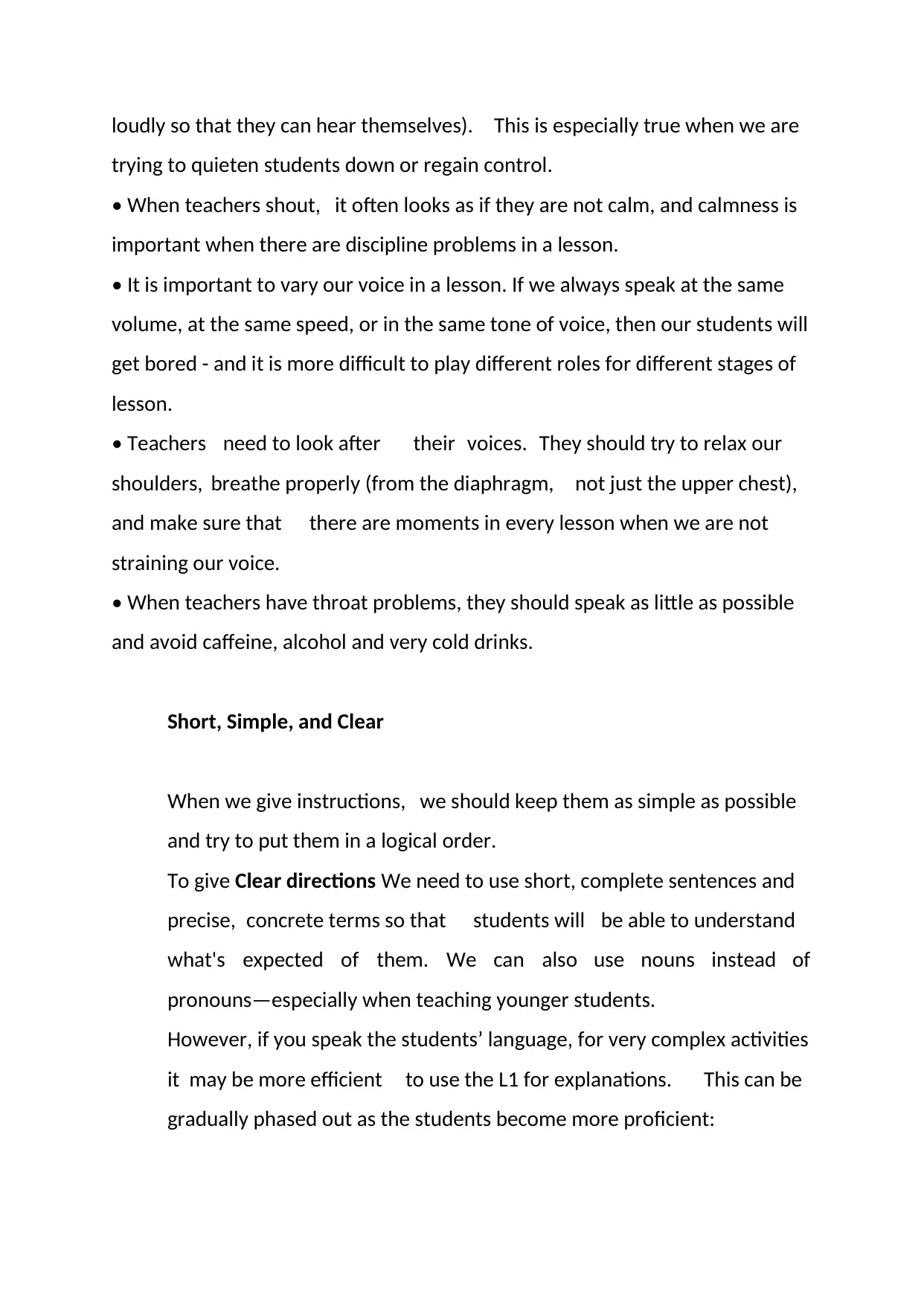
loudly so that they can hear themselves). This is especially true when we are
trying to quieten students down or regain control.
• When teachers shout, it often looks as if they are not calm, and calmness is
important when there are discipline problems in a lesson.
• It is important to vary our voice in a lesson. If we always speak at the same
volume, at the same speed, or in the same tone of voice, then our students will
get bored - and it is more difficult to play different roles for different stages of
lesson.
• Teachers need to look after their voices. They should try to relax our
shoulders, breathe properly (from the diaphragm, not just the upper chest),
and make sure that there are moments in every lesson when we are not
straining our voice.
• When teachers have throat problems, they should speak as little as possible
and avoid caffeine, alcohol and very cold drinks.
Short, Simple, and Clear
When we give instructions, we should keep them as simple as possible
and try to put them in a logical order.
To give Clear directions We need to use short, complete sentences and
precise, concrete terms so that students will be able to understand
what's expected of them. We can also use nouns instead of
pronouns—especially when teaching younger students.
However, if you speak the students’ language, for very complex activities
it may be more efficient to use the L1 for explanations. This can be
gradually phased out as the students become more proficient:
trying to quieten students down or regain control.
• When teachers shout, it often looks as if they are not calm, and calmness is
important when there are discipline problems in a lesson.
• It is important to vary our voice in a lesson. If we always speak at the same
volume, at the same speed, or in the same tone of voice, then our students will
get bored - and it is more difficult to play different roles for different stages of
lesson.
• Teachers need to look after their voices. They should try to relax our
shoulders, breathe properly (from the diaphragm, not just the upper chest),
and make sure that there are moments in every lesson when we are not
straining our voice.
• When teachers have throat problems, they should speak as little as possible
and avoid caffeine, alcohol and very cold drinks.
Short, Simple, and Clear
When we give instructions, we should keep them as simple as possible
and try to put them in a logical order.
To give Clear directions We need to use short, complete sentences and
precise, concrete terms so that students will be able to understand
what's expected of them. We can also use nouns instead of
pronouns—especially when teaching younger students.
However, if you speak the students’ language, for very complex activities
it may be more efficient to use the L1 for explanations. This can be
gradually phased out as the students become more proficient:
Paraphrase This Document
Need a fresh take? Get an instant paraphrase of this document with our AI Paraphraser
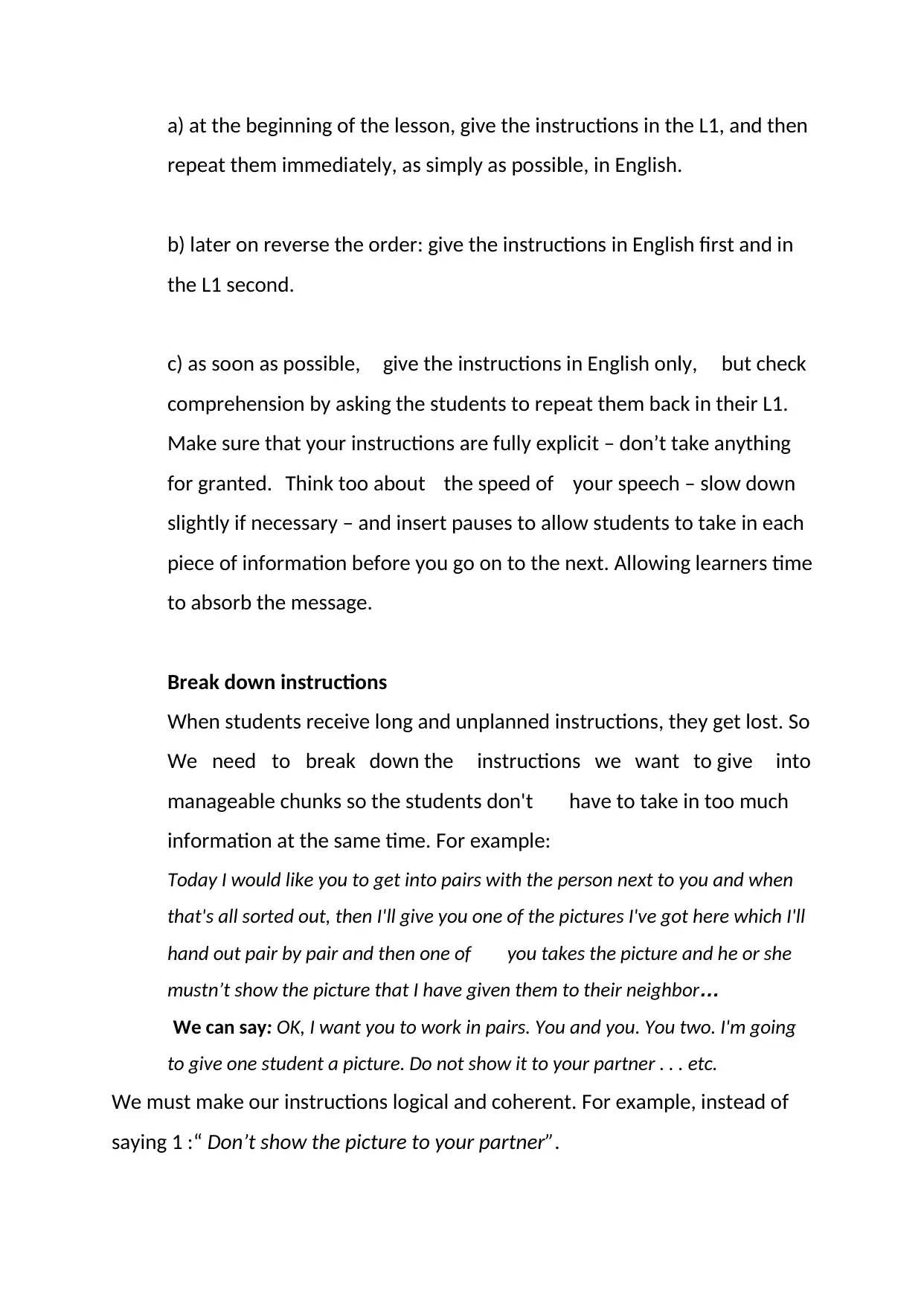
a) at the beginning of the lesson, give the instructions in the L1, and then
repeat them immediately, as simply as possible, in English.
b) later on reverse the order: give the instructions in English first and in
the L1 second.
c) as soon as possible, give the instructions in English only, but check
comprehension by asking the students to repeat them back in their L1.
Make sure that your instructions are fully explicit – don’t take anything
for granted. Think too about the speed of your speech – slow down
slightly if necessary – and insert pauses to allow students to take in each
piece of information before you go on to the next. Allowing learners time
to absorb the message.
Break down instructions
When students receive long and unplanned instructions, they get lost. So
We need to break down the instructions we want to give into
manageable chunks so the students don't have to take in too much
information at the same time. For example:
Today I would like you to get into pairs with the person next to you and when
that's all sorted out, then I'll give you one of the pictures I've got here which I'll
hand out pair by pair and then one of you takes the picture and he or she
mustn’t show the picture that I have given them to their neighbor…
We can say: OK, I want you to work in pairs. You and you. You two. I'm going
to give one student a picture. Do not show it to your partner . . . etc.
We must make our instructions logical and coherent. For example, instead of
saying 1 :“ Don’t show the picture to your partner”.
repeat them immediately, as simply as possible, in English.
b) later on reverse the order: give the instructions in English first and in
the L1 second.
c) as soon as possible, give the instructions in English only, but check
comprehension by asking the students to repeat them back in their L1.
Make sure that your instructions are fully explicit – don’t take anything
for granted. Think too about the speed of your speech – slow down
slightly if necessary – and insert pauses to allow students to take in each
piece of information before you go on to the next. Allowing learners time
to absorb the message.
Break down instructions
When students receive long and unplanned instructions, they get lost. So
We need to break down the instructions we want to give into
manageable chunks so the students don't have to take in too much
information at the same time. For example:
Today I would like you to get into pairs with the person next to you and when
that's all sorted out, then I'll give you one of the pictures I've got here which I'll
hand out pair by pair and then one of you takes the picture and he or she
mustn’t show the picture that I have given them to their neighbor…
We can say: OK, I want you to work in pairs. You and you. You two. I'm going
to give one student a picture. Do not show it to your partner . . . etc.
We must make our instructions logical and coherent. For example, instead of
saying 1 :“ Don’t show the picture to your partner”.
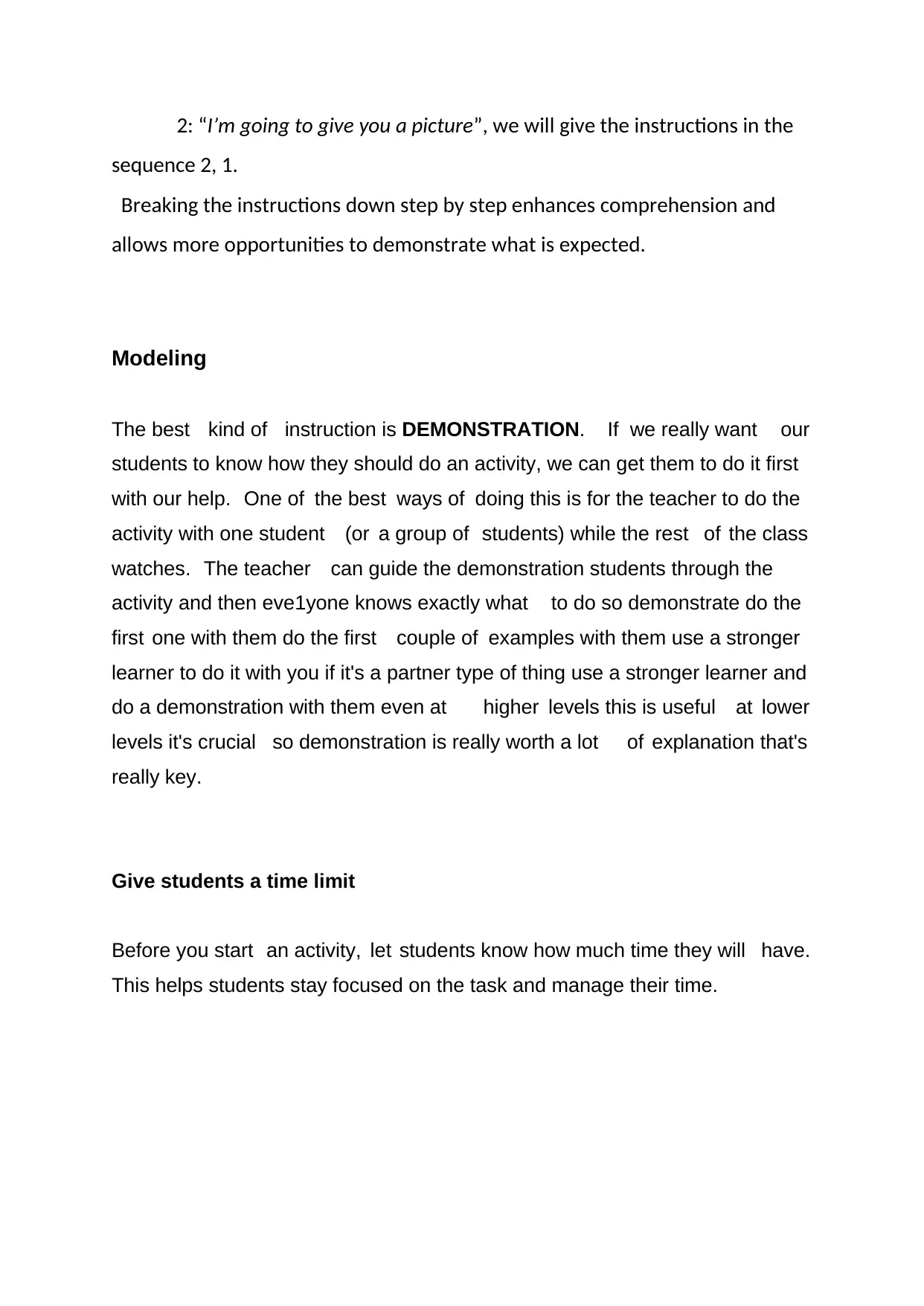
2: “I’m going to give you a picture”, we will give the instructions in the
sequence 2, 1.
Breaking the instructions down step by step enhances comprehension and
allows more opportunities to demonstrate what is expected.
Modeling
The best kind of instruction is DEMONSTRATION. If we really want our
students to know how they should do an activity, we can get them to do it first
with our help. One of the best ways of doing this is for the teacher to do the
activity with one student (or a group of students) while the rest of the class
watches. The teacher can guide the demonstration students through the
activity and then eve1yone knows exactly what to do so demonstrate do the
first one with them do the first couple of examples with them use a stronger
learner to do it with you if it's a partner type of thing use a stronger learner and
do a demonstration with them even at higher levels this is useful at lower
levels it's crucial so demonstration is really worth a lot of explanation that's
really key.
Give students a time limit
Before you start an activity, let students know how much time they will have.
This helps students stay focused on the task and manage their time.
sequence 2, 1.
Breaking the instructions down step by step enhances comprehension and
allows more opportunities to demonstrate what is expected.
Modeling
The best kind of instruction is DEMONSTRATION. If we really want our
students to know how they should do an activity, we can get them to do it first
with our help. One of the best ways of doing this is for the teacher to do the
activity with one student (or a group of students) while the rest of the class
watches. The teacher can guide the demonstration students through the
activity and then eve1yone knows exactly what to do so demonstrate do the
first one with them do the first couple of examples with them use a stronger
learner to do it with you if it's a partner type of thing use a stronger learner and
do a demonstration with them even at higher levels this is useful at lower
levels it's crucial so demonstration is really worth a lot of explanation that's
really key.
Give students a time limit
Before you start an activity, let students know how much time they will have.
This helps students stay focused on the task and manage their time.
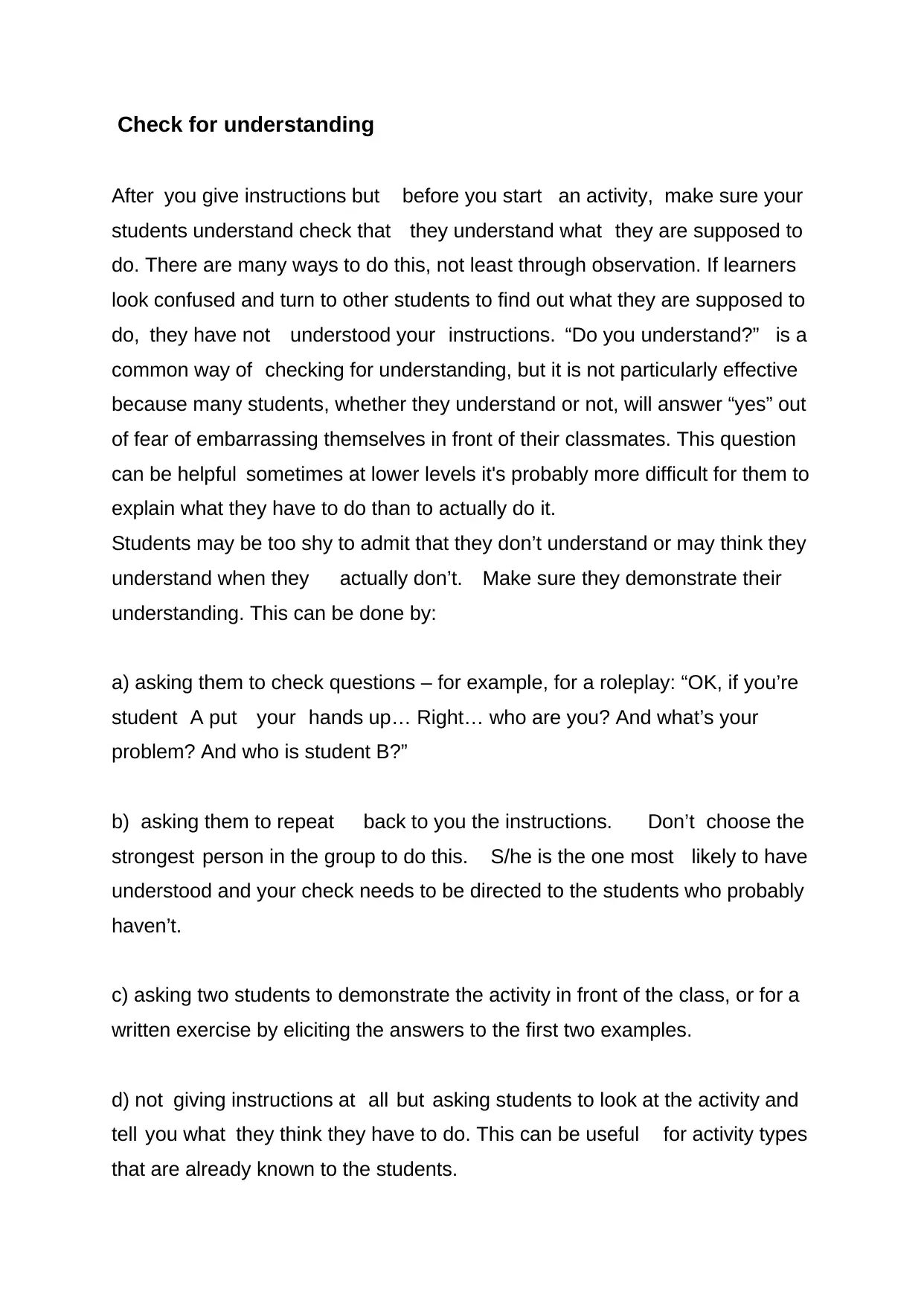
Check for understanding
After you give instructions but before you start an activity, make sure your
students understand check that they understand what they are supposed to
do. There are many ways to do this, not least through observation. If learners
look confused and turn to other students to find out what they are supposed to
do, they have not understood your instructions. “Do you understand?” is a
common way of checking for understanding, but it is not particularly effective
because many students, whether they understand or not, will answer “yes” out
of fear of embarrassing themselves in front of their classmates. This question
can be helpful sometimes at lower levels it's probably more difficult for them to
explain what they have to do than to actually do it.
Students may be too shy to admit that they don’t understand or may think they
understand when they actually don’t. Make sure they demonstrate their
understanding. This can be done by:
a) asking them to check questions – for example, for a roleplay: “OK, if you’re
student A put your hands up… Right… who are you? And what’s your
problem? And who is student B?”
b) asking them to repeat back to you the instructions. Don’t choose the
strongest person in the group to do this. S/he is the one most likely to have
understood and your check needs to be directed to the students who probably
haven’t.
c) asking two students to demonstrate the activity in front of the class, or for a
written exercise by eliciting the answers to the first two examples.
d) not giving instructions at all but asking students to look at the activity and
tell you what they think they have to do. This can be useful for activity types
that are already known to the students.
After you give instructions but before you start an activity, make sure your
students understand check that they understand what they are supposed to
do. There are many ways to do this, not least through observation. If learners
look confused and turn to other students to find out what they are supposed to
do, they have not understood your instructions. “Do you understand?” is a
common way of checking for understanding, but it is not particularly effective
because many students, whether they understand or not, will answer “yes” out
of fear of embarrassing themselves in front of their classmates. This question
can be helpful sometimes at lower levels it's probably more difficult for them to
explain what they have to do than to actually do it.
Students may be too shy to admit that they don’t understand or may think they
understand when they actually don’t. Make sure they demonstrate their
understanding. This can be done by:
a) asking them to check questions – for example, for a roleplay: “OK, if you’re
student A put your hands up… Right… who are you? And what’s your
problem? And who is student B?”
b) asking them to repeat back to you the instructions. Don’t choose the
strongest person in the group to do this. S/he is the one most likely to have
understood and your check needs to be directed to the students who probably
haven’t.
c) asking two students to demonstrate the activity in front of the class, or for a
written exercise by eliciting the answers to the first two examples.
d) not giving instructions at all but asking students to look at the activity and
tell you what they think they have to do. This can be useful for activity types
that are already known to the students.
Secure Best Marks with AI Grader
Need help grading? Try our AI Grader for instant feedback on your assignments.

As soon as the students start the activity, we can go around quickly to each
pair or group just to check they are on task. Don’t stop to help or monitor one
group until you have checked them all. If only one group has not understood,
then go back and help. If several groups are off track, then stop the activity
and explain again, using the students who have understood to demonstrate to
the others.
Throughout an activity, periodically monitor students and make yourself
readily available for assistance. While you do not want to be an imposing or
threatening presence, students should know that you are present and involved
in what they are doing.
Use a Variety of Instruction Methods
Another common problem is giving instructions verbally. This is fine and
something I do for every single activity in my classroom. However, you should
consider giving them in some other way as well.
For example, you might want to make a PPT slide or write a few bullet points
on the board. For more complicated things like homework, you’ll probably
want to make a handout of some kind for students to refer to, such as:
Explainer video
Use apps like Explain Everything or Simpleshow video maker to create your
own explainer video of the lesson content. It’s very easy to create and it allows
students to go through them at their own pace. If they didn’t understand
something, they can just look back at the explainer video and pick up their
learning again.
Quiz with automatic feedback function
pair or group just to check they are on task. Don’t stop to help or monitor one
group until you have checked them all. If only one group has not understood,
then go back and help. If several groups are off track, then stop the activity
and explain again, using the students who have understood to demonstrate to
the others.
Throughout an activity, periodically monitor students and make yourself
readily available for assistance. While you do not want to be an imposing or
threatening presence, students should know that you are present and involved
in what they are doing.
Use a Variety of Instruction Methods
Another common problem is giving instructions verbally. This is fine and
something I do for every single activity in my classroom. However, you should
consider giving them in some other way as well.
For example, you might want to make a PPT slide or write a few bullet points
on the board. For more complicated things like homework, you’ll probably
want to make a handout of some kind for students to refer to, such as:
Explainer video
Use apps like Explain Everything or Simpleshow video maker to create your
own explainer video of the lesson content. It’s very easy to create and it allows
students to go through them at their own pace. If they didn’t understand
something, they can just look back at the explainer video and pick up their
learning again.
Quiz with automatic feedback function
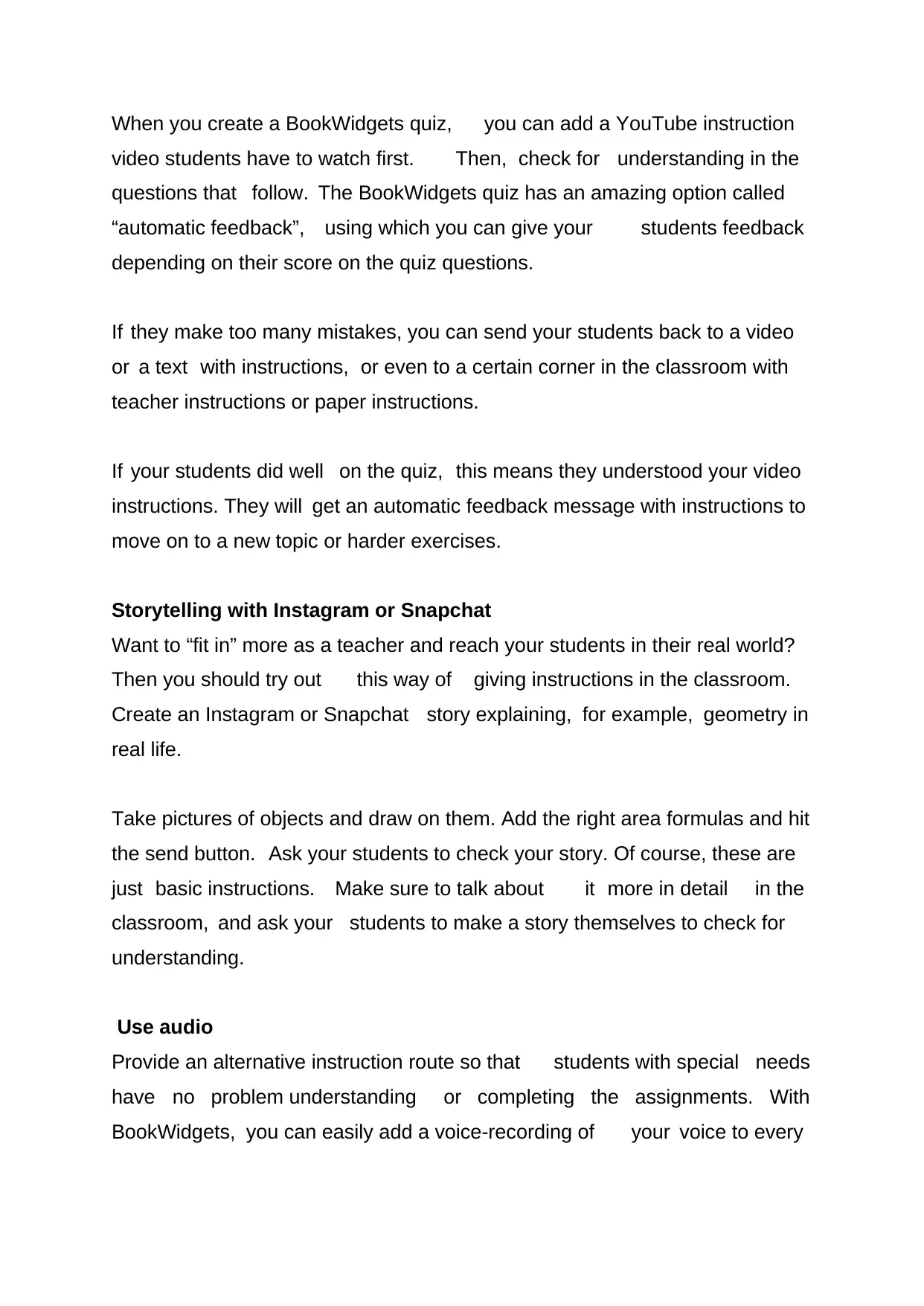
When you create a BookWidgets quiz, you can add a YouTube instruction
video students have to watch first. Then, check for understanding in the
questions that follow. The BookWidgets quiz has an amazing option called
“automatic feedback”, using which you can give your students feedback
depending on their score on the quiz questions.
If they make too many mistakes, you can send your students back to a video
or a text with instructions, or even to a certain corner in the classroom with
teacher instructions or paper instructions.
If your students did well on the quiz, this means they understood your video
instructions. They will get an automatic feedback message with instructions to
move on to a new topic or harder exercises.
Storytelling with Instagram or Snapchat
Want to “fit in” more as a teacher and reach your students in their real world?
Then you should try out this way of giving instructions in the classroom.
Create an Instagram or Snapchat story explaining, for example, geometry in
real life.
Take pictures of objects and draw on them. Add the right area formulas and hit
the send button. Ask your students to check your story. Of course, these are
just basic instructions. Make sure to talk about it more in detail in the
classroom, and ask your students to make a story themselves to check for
understanding.
Use audio
Provide an alternative instruction route so that students with special needs
have no problem understanding or completing the assignments. With
BookWidgets, you can easily add a voice-recording of your voice to every
video students have to watch first. Then, check for understanding in the
questions that follow. The BookWidgets quiz has an amazing option called
“automatic feedback”, using which you can give your students feedback
depending on their score on the quiz questions.
If they make too many mistakes, you can send your students back to a video
or a text with instructions, or even to a certain corner in the classroom with
teacher instructions or paper instructions.
If your students did well on the quiz, this means they understood your video
instructions. They will get an automatic feedback message with instructions to
move on to a new topic or harder exercises.
Storytelling with Instagram or Snapchat
Want to “fit in” more as a teacher and reach your students in their real world?
Then you should try out this way of giving instructions in the classroom.
Create an Instagram or Snapchat story explaining, for example, geometry in
real life.
Take pictures of objects and draw on them. Add the right area formulas and hit
the send button. Ask your students to check your story. Of course, these are
just basic instructions. Make sure to talk about it more in detail in the
classroom, and ask your students to make a story themselves to check for
understanding.
Use audio
Provide an alternative instruction route so that students with special needs
have no problem understanding or completing the assignments. With
BookWidgets, you can easily add a voice-recording of your voice to every
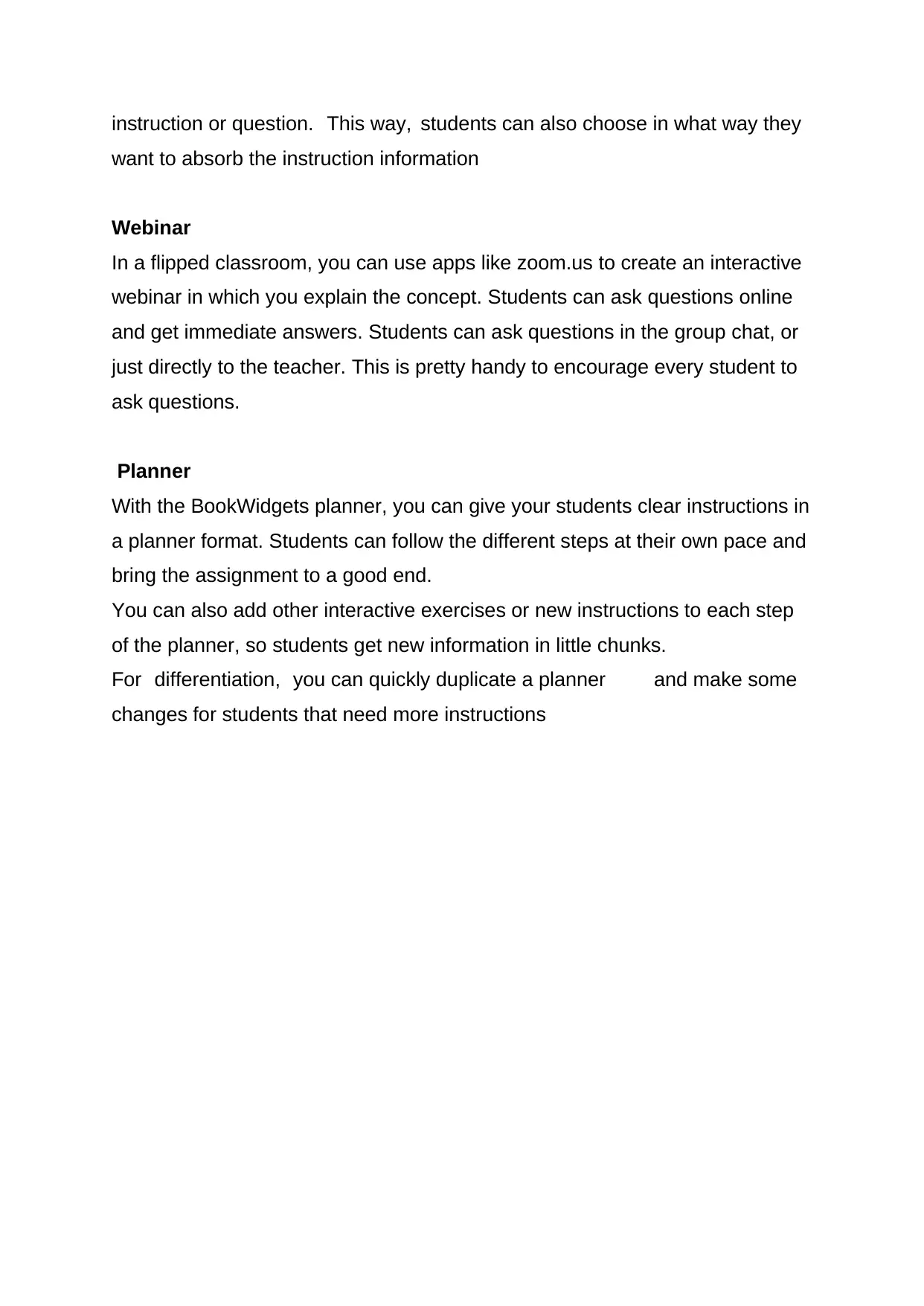
instruction or question. This way, students can also choose in what way they
want to absorb the instruction information
Webinar
In a flipped classroom, you can use apps like zoom.us to create an interactive
webinar in which you explain the concept. Students can ask questions online
and get immediate answers. Students can ask questions in the group chat, or
just directly to the teacher. This is pretty handy to encourage every student to
ask questions.
Planner
With the BookWidgets planner, you can give your students clear instructions in
a planner format. Students can follow the different steps at their own pace and
bring the assignment to a good end.
You can also add other interactive exercises or new instructions to each step
of the planner, so students get new information in little chunks.
For differentiation, you can quickly duplicate a planner and make some
changes for students that need more instructions
want to absorb the instruction information
Webinar
In a flipped classroom, you can use apps like zoom.us to create an interactive
webinar in which you explain the concept. Students can ask questions online
and get immediate answers. Students can ask questions in the group chat, or
just directly to the teacher. This is pretty handy to encourage every student to
ask questions.
Planner
With the BookWidgets planner, you can give your students clear instructions in
a planner format. Students can follow the different steps at their own pace and
bring the assignment to a good end.
You can also add other interactive exercises or new instructions to each step
of the planner, so students get new information in little chunks.
For differentiation, you can quickly duplicate a planner and make some
changes for students that need more instructions
Paraphrase This Document
Need a fresh take? Get an instant paraphrase of this document with our AI Paraphraser
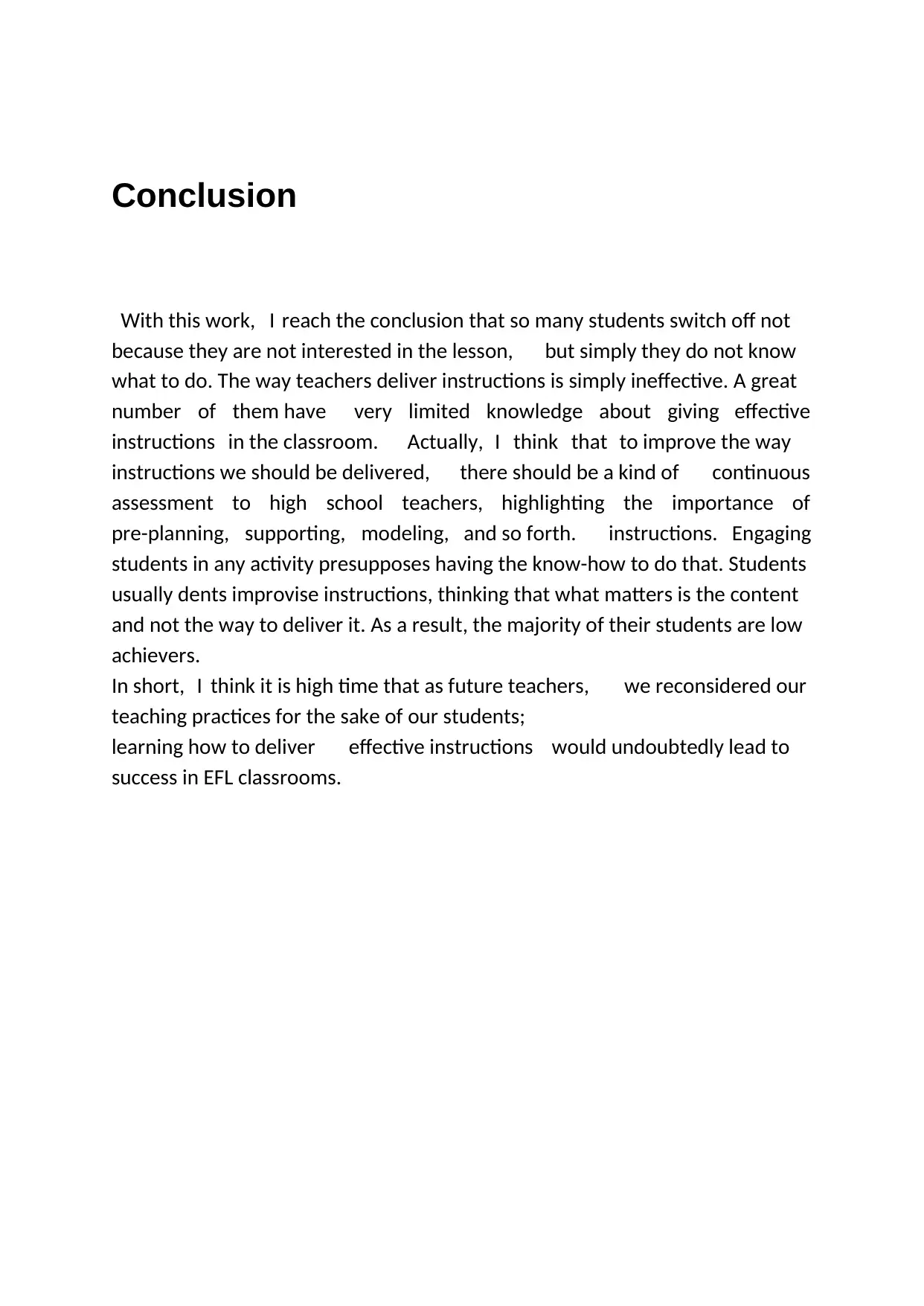
Conclusion
With this work, I reach the conclusion that so many students switch off not
because they are not interested in the lesson, but simply they do not know
what to do. The way teachers deliver instructions is simply ineffective. A great
number of them have very limited knowledge about giving effective
instructions in the classroom. Actually, I think that to improve the way
instructions we should be delivered, there should be a kind of continuous
assessment to high school teachers, highlighting the importance of
pre-planning, supporting, modeling, and so forth. instructions. Engaging
students in any activity presupposes having the know-how to do that. Students
usually dents improvise instructions, thinking that what matters is the content
and not the way to deliver it. As a result, the majority of their students are low
achievers.
In short, I think it is high time that as future teachers, we reconsidered our
teaching practices for the sake of our students;
learning how to deliver effective instructions would undoubtedly lead to
success in EFL classrooms.
With this work, I reach the conclusion that so many students switch off not
because they are not interested in the lesson, but simply they do not know
what to do. The way teachers deliver instructions is simply ineffective. A great
number of them have very limited knowledge about giving effective
instructions in the classroom. Actually, I think that to improve the way
instructions we should be delivered, there should be a kind of continuous
assessment to high school teachers, highlighting the importance of
pre-planning, supporting, modeling, and so forth. instructions. Engaging
students in any activity presupposes having the know-how to do that. Students
usually dents improvise instructions, thinking that what matters is the content
and not the way to deliver it. As a result, the majority of their students are low
achievers.
In short, I think it is high time that as future teachers, we reconsidered our
teaching practices for the sake of our students;
learning how to deliver effective instructions would undoubtedly lead to
success in EFL classrooms.
1 out of 14
Related Documents
Your All-in-One AI-Powered Toolkit for Academic Success.
+13062052269
info@desklib.com
Available 24*7 on WhatsApp / Email
![[object Object]](/_next/static/media/star-bottom.7253800d.svg)
Unlock your academic potential
© 2024 | Zucol Services PVT LTD | All rights reserved.





